Gongzheng Tang
National Institute of Health Data Science, Peking University, Beijing, China
KidneyTalk-open: No-code Deployment of a Private Large Language Model with Medical Documentation-Enhanced Knowledge Database for Kidney Disease
Mar 06, 2025Abstract:Privacy-preserving medical decision support for kidney disease requires localized deployment of large language models (LLMs) while maintaining clinical reasoning capabilities. Current solutions face three challenges: 1) Cloud-based LLMs pose data security risks; 2) Local model deployment demands technical expertise; 3) General LLMs lack mechanisms to integrate medical knowledge. Retrieval-augmented systems also struggle with medical document processing and clinical usability. We developed KidneyTalk-open, a desktop system integrating three technical components: 1) No-code deployment of state-of-the-art (SOTA) open-source LLMs (such as DeepSeek-r1, Qwen2.5) via local inference engine; 2) Medical document processing pipeline combining context-aware chunking and intelligent filtering; 3) Adaptive Retrieval and Augmentation Pipeline (AddRep) employing agents collaboration for improving the recall rate of medical documents. A graphical interface was designed to enable clinicians to manage medical documents and conduct AI-powered consultations without technical expertise. Experimental validation on 1,455 challenging nephrology exam questions demonstrates AddRep's effectiveness: achieving 29.1% accuracy (+8.1% over baseline) with intelligent knowledge integration, while maintaining robustness through 4.9% rejection rate to suppress hallucinations. Comparative case studies with the mainstream products (AnythingLLM, Chatbox, GPT4ALL) demonstrate KidneyTalk-open's superior performance in real clinical query. KidneyTalk-open represents the first no-code medical LLM system enabling secure documentation-enhanced medical Q&A on desktop. Its designs establishes a new framework for privacy-sensitive clinical AI applications. The system significantly lowers technical barriers while improving evidence traceability, enabling more medical staff or patients to use SOTA open-source LLMs conveniently.
Artificial Intelligence-derived Vascular Age from Photoplethysmography: A Novel Digital Biomarker for Cardiovascular Health
Feb 19, 2025Abstract:With the increasing availability of wearable devices, photoplethysmography (PPG) has emerged as a promising non-invasive tool for monitoring human hemodynamics. We propose a deep learning framework to estimate vascular age (AI-vascular age) from PPG signals, incorporating a distribution-aware loss to address biases caused by imbalanced data. The model was developed using data from the UK Biobank (UKB), with 98,672 participants in the development cohort and 113,559 participants (144,683 data pairs) for clinical evaluation. After adjusting for key confounders, individuals with a vascular age gap (AI-vascular age minus calendar age) exceeding 9 years had a significantly higher risk of major adverse cardiovascular and cerebrovascular events (MACCE) (HR = 2.37, p < 0.005) and secondary outcomes, including diabetes (HR = 2.69, p < 0.005), hypertension (HR = 2.88, p < 0.005), coronary heart disease (HR = 2.20, p < 0.005), heart failure (HR = 2.15, p < 0.005), myocardial infarction (HR = 2.51, p < 0.005), stroke (HR = 2.55, p < 0.005), and all-cause mortality (HR = 2.51, p < 0.005). Conversely, participants with a vascular age gap below -9 years exhibited a significantly lower incidence of these outcomes. We further evaluated the longitudinal applicability of AI-vascular age using serial PPG data from the UKB, demonstrating its value in risk stratification by leveraging AI-vascular age at two distinct time points to predict future MACCE incidence. External validation was performed on a MIMIC-III-derived cohort (n = 2,343), where each one-year increase in vascular age gap was significantly associated with elevated in-hospital mortality risk (OR = 1.02, p < 0.005). In conclusion, our study establishes AI-vascular age as a novel, non-invasive digital biomarker for cardiovascular health assessment.
Dist Loss: Enhancing Regression in Few-Shot Region through Distribution Distance Constraint
Nov 20, 2024
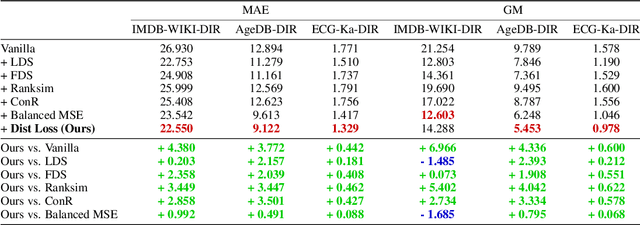
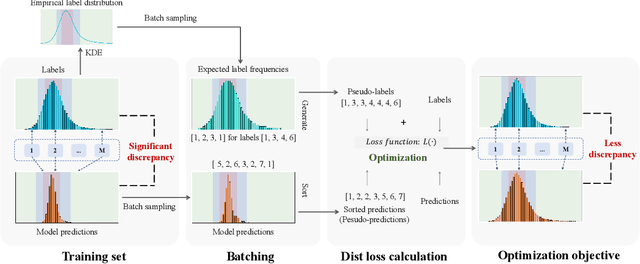

Abstract:Imbalanced data distributions are prevalent in real-world scenarios, posing significant challenges in both imbalanced classification and imbalanced regression tasks. They often cause deep learning models to overfit in areas of high sample density (many-shot regions) while underperforming in areas of low sample density (few-shot regions). This characteristic restricts the utility of deep learning models in various sectors, notably healthcare, where areas with few-shot data hold greater clinical relevance. While recent studies have shown the benefits of incorporating distribution information in imbalanced classification tasks, such strategies are rarely explored in imbalanced regression. In this paper, we address this issue by introducing a novel loss function, termed Dist Loss, designed to minimize the distribution distance between the model's predictions and the target labels in a differentiable manner, effectively integrating distribution information into model training. Dist Loss enables deep learning models to regularize their output distribution during training, effectively enhancing their focus on few-shot regions. We have conducted extensive experiments across three datasets spanning computer vision and healthcare: IMDB-WIKI-DIR, AgeDB-DIR, and ECG-Ka-DIR. The results demonstrate that Dist Loss effectively mitigates the negative impact of imbalanced data distribution on model performance, achieving state-of-the-art results in sparse data regions. Furthermore, Dist Loss is easy to integrate, complementing existing methods.
Deep Imbalanced Regression to Estimate Vascular Age from PPG Data: a Novel Digital Biomarker for Cardiovascular Health
Jun 21, 2024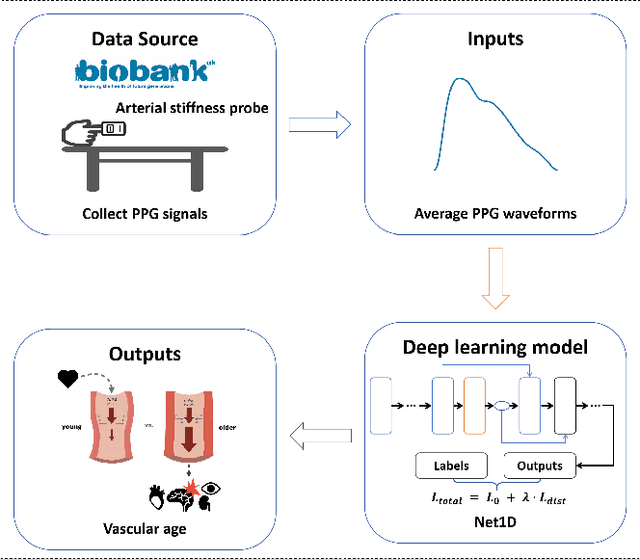
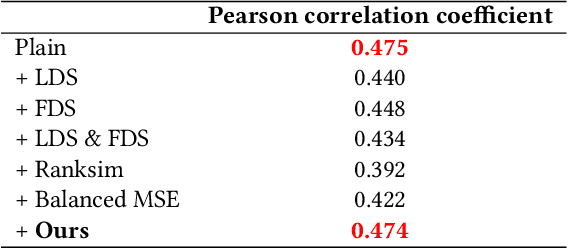
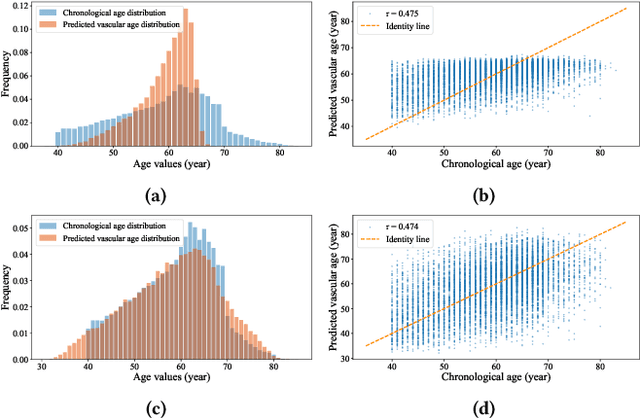

Abstract:Photoplethysmography (PPG) is emerging as a crucial tool for monitoring human hemodynamics, with recent studies highlighting its potential in assessing vascular aging through deep learning. However, real-world age distributions are often imbalanced, posing significant challenges for deep learning models. In this paper, we introduce a novel, simple, and effective loss function named the Dist Loss to address deep imbalanced regression tasks. We trained a one-dimensional convolutional neural network (Net1D) incorporating the Dist Loss on the extensive UK Biobank dataset (n=502,389) to estimate vascular age from PPG signals and validate its efficacy in characterizing cardiovascular health. The model's performance was validated on a 40% held-out test set, achieving state-of-the-art results, especially in regions with small sample sizes. Furthermore, we divided the population into three subgroups based on the difference between predicted vascular age and chronological age: less than -10 years, between -10 and 10 years, and greater than 10 years. We analyzed the relationship between predicted vascular age and several cardiovascular events over a follow-up period of up to 10 years, including death, coronary heart disease, and heart failure. Our results indicate that the predicted vascular age has significant potential to reflect an individual's cardiovascular health status. Our code will be available at https://github.com/Ngk03/AI-vascular-age.
A Review of Deep Learning Methods for Photoplethysmography Data
Jan 23, 2024Abstract:Photoplethysmography (PPG) is a highly promising device due to its advantages in portability, user-friendly operation, and non-invasive capabilities to measure a wide range of physiological information. Recent advancements in deep learning have demonstrated remarkable outcomes by leveraging PPG signals for tasks related to personal health management and other multifaceted applications. In this review, we systematically reviewed papers that applied deep learning models to process PPG data between January 1st of 2017 and July 31st of 2023 from Google Scholar, PubMed and Dimensions. Each paper is analyzed from three key perspectives: tasks, models, and data. We finally extracted 193 papers where different deep learning frameworks were used to process PPG signals. Based on the tasks addressed in these papers, we categorized them into two major groups: medical-related, and non-medical-related. The medical-related tasks were further divided into seven subgroups, including blood pressure analysis, cardiovascular monitoring and diagnosis, sleep health, mental health, respiratory monitoring and analysis, blood glucose analysis, as well as others. The non-medical-related tasks were divided into four subgroups, which encompass signal processing, biometric identification, electrocardiogram reconstruction, and human activity recognition. In conclusion, significant progress has been made in the field of using deep learning methods to process PPG data recently. This allows for a more thorough exploration and utilization of the information contained in PPG signals. However, challenges remain, such as limited quantity and quality of publicly available databases, a lack of effective validation in real-world scenarios, and concerns about the interpretability, scalability, and complexity of deep learning models. Moreover, there are still emerging research areas that require further investigation.
 Add to Chrome
Add to Chrome Add to Firefox
Add to Firefox Add to Edge
Add to Edge